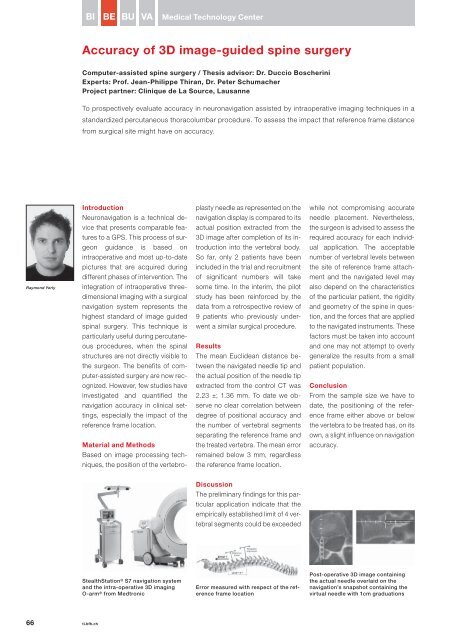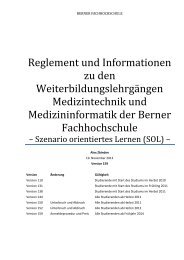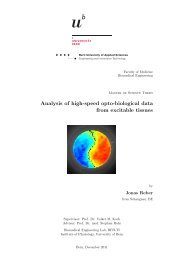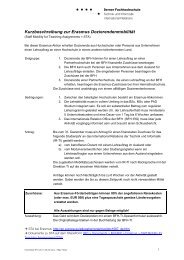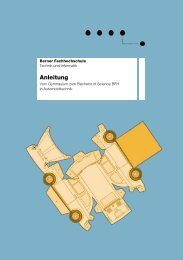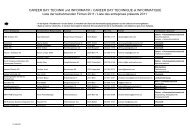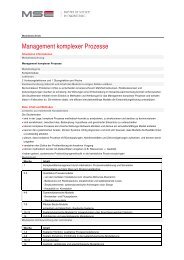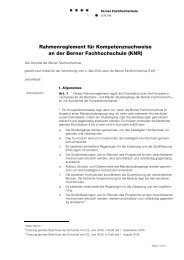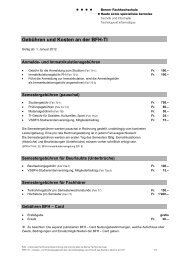Dernière édition Attention: Le pdf pèse environ 17 - BFH-TI - Berner ...
Dernière édition Attention: Le pdf pèse environ 17 - BFH-TI - Berner ...
Dernière édition Attention: Le pdf pèse environ 17 - BFH-TI - Berner ...
- Keine Tags gefunden...
Sie wollen auch ein ePaper? Erhöhen Sie die Reichweite Ihrer Titel.
YUMPU macht aus Druck-PDFs automatisch weboptimierte ePaper, die Google liebt.
BIBEBUVAMedical Technology CenterAccuracy of 3D image-guided spine surgeryComputer-assisted spine surgery / Thesis advisor: Dr. Duccio BoscheriniExperts: Prof. Jean-Philippe Thiran, Dr. Peter SchumacherProject partner: Clinique de La Source, LausanneTo prospectively evaluate accuracy in neuronavigation assisted by intraoperative imaging techniques in astandardized percutaneous thoracolumbar procedure. To assess the impact that reference frame distancefrom surgical site might have on accuracy.Raymond YerlyIntroductionNeuronavigation is a technical devicethat presents comparable featuresto a GPS. This process of surgeonguidance is based onintraoperative and most up-to-datepictures that are acquired duringdifferent phases of intervention. Theintegration of intraoperative threedimensionalimaging with a surgicalnavigation system represents thehighest standard of image guidedspinal surgery. This technique isparticularly useful during percutaneousprocedures, when the spinalstructures are not directly visible tothe surgeon. The benefits of computer-assistedsurgery are now recognized.However, few studies haveinvestigated and quantified thenavigation accuracy in clinical settings,especially the impact of thereference frame location.Material and MethodsBased on image processing techniques,the position of the vertebroplastyneedle as represented on thenavigation display is compared to itsactual position extracted from the3D image after completion of its introductioninto the vertebral body.So far, only 2 patients have beenincluded in the trial and recruitmentof significant numbers will takesome time. In the interim, the pilotstudy has been reinforced by thedata from a retrospective review of9 patients who previously underwenta similar surgical procedure.ResultsThe mean Euclidean distance betweenthe navigated needle tip andthe actual position of the needle tipextracted from the control CT was2.23 ±; 1.36 mm. To date we observeno clear correlation betweendegree of positional accuracy andthe number of vertebral segmentsseparating the reference frame andthe treated vertebra. The mean errorremained below 3 mm, regardlessthe reference frame location.while not compromising accurateneedle placement. Nevertheless,the surgeon is advised to assess therequired accuracy for each individualapplication. The acceptablenumber of vertebral levels betweenthe site of reference frame attachmentand the navigated level mayalso depend on the characteristicsof the particular patient, the rigidityand geometry of the spine in question,and the forces that are appliedto the navigated instruments. Thesefactors must be taken into accountand one may not attempt to overlygeneralize the results from a smallpatient population.ConclusionFrom the sample size we have todate, the positioning of the referenceframe either above or belowthe vertebra to be treated has, on itsown, a slight influence on navigationaccuracy.DiscussionThe preliminary findings for this particularapplication indicate that theempirically established limit of 4 vertebralsegments could be exceededStealthStation ® S7 navigation systemand the intra- operative 3D imagingO- arm ® from MedtronicError measured with respect of the referenceframe locationPost-operative 3D image containingthe actual needle overlaid on thenavigation’s snapshot containing thevirtual needle with 1cm graduations66 ti.bfh.ch


